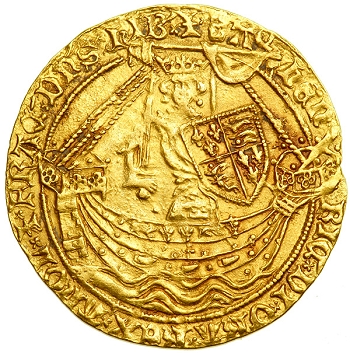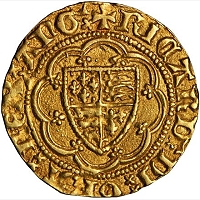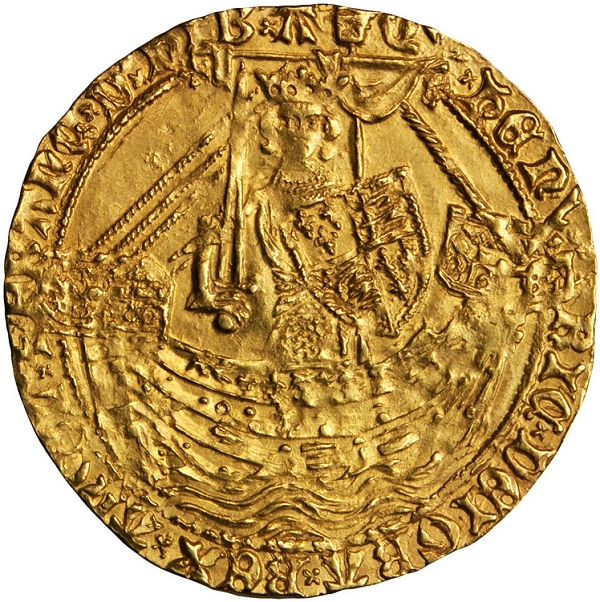GREAT BRITAIN. Henry IV, 1399-1413. Noble
A Weekly CoinWeek Column by Greg Reynolds …..
Analysis regarding scarce coins, markets, and coin collecting #346
This discussion is about the English Gold Noble coins of Richard II (ruled 1377-99), Henry IV (r. 1399-1413) and Henry V (r. 1413-22). A month ago, the topic was the English Gold Nobles of King Edward III (1327-77). These were the first widely used, large gold coins of the British Isles, and became an international standard. Gold Noble coins directly relate to significant economic growth and England’s emergence as a superpower.
The same design types for all three denominations of English Gold Nobles were employed for more than a century. Although later Nobles are not quite as historically important as those of Edward III, all are fascinating, rare and good values for collectors in the current coin market environment.
Edward III had a long reign and his forces clutched France for decades. There is no doubt that, during his reign, England became a superpower both militarily and economically. The brief reign of King Henry V was, in important ways, characterized by the continuation of the policies of Edward III. The reigns of Richard II and Henry IV, in contrast, were characterized by power struggles within England and were not impressive overall.
Historical Setting
Richard II became king when he was only 10 years old and was overthrown when he was 32. He was often pre-occupied with internal discord, as he never really had the support of leading lords nor most other aristocrats. Richard II had little interest in the military objectives of his grandfather Edward III, and Richard was enthusiastic about the arts. His leadership skills were not exceptional, and his reign was subject to frequent challenges.
Richard’s successor, King Henry IV, had even less support from leading lords and other influential figures. Henry of Bolingbroke became King Henry IV in 1399. His father was John of Gaunt, a leading duke, who was effectively chief of state while Richard II was a boy-king. John of Gaunt, though, was opportunistic and exceeded his authority. Eventually Richard retaliated against John and his son. So, Henry led forces that overthrew and captured Richard II, who died in 1400 under mysterious circumstances.
Henry IV (of Bolingbroke) was a grandson of King Edward III and a descendant of King Henry III. He and Richard II were cousins. Even so, Henry IV was never really accepted as the king by leading lords. He was not, by any standard, high in the line of succession.
King Henry IV devoted considerable resources to fighting a rebellion in Wales and never seemed to be in control of England. Additionally, he lacked skills relating to finance, economics and business. During much of his reign, King Henry IV suffered from serious health problems, which interfered with his duties as king.
 His son, Henry V, was much more successful at consolidating power and leading England. Indeed, King Henry V was a military genius and a very competent chief executive overall. He earned the support of most influential citizens.
His son, Henry V, was much more successful at consolidating power and leading England. Indeed, King Henry V was a military genius and a very competent chief executive overall. He earned the support of most influential citizens.
For the most part, King Henry V continued the foreign policy of Edward III, his great-grandfather. The general power and international reach of England increased. Henry’s courageous defeats of the French on multiple fronts forced the French to agree to terms that were very beneficial to England and were consistent with England’s expansionist policies.
Henry V became king in 1413. By 1420, England controlled much of France and seemed poised to rule the whole nation. Early in 1421, however, England’s forces suffered losses in battles with the French and Scots. An important general, Henry’s brother the Duke of Clarence, was killed. Henry V returned to France and personally orchestrated a comeback. The king, however, became ill, abruptly returned to England, and died in 1422.
His nine-year reign was extremely successful, and Henry V became a legend. Many coins were minted during those nine years, and quite a few survive.
The Nobles of Henry VI and Edward IV will be treated separately in the future. Their respective reigns are more complicated, as each had two reigns as king. Moreover, England became embroiled in a civil conflict, a competition between two branches of the royal family. Some historians figure that Henry IV started this conflict in 1399 by violently revolting against King Richard II, his cousin.
It seems fitting for Gold Noble coins to be discontinued during an especially heated phase of an internal conflict that rocked England for decades. During the reigns of Edward III and Henry V, though, England was united, powerful and rising.
The people of England were then confident and thinking about national power. Of course, collectors do not have to agree with the political views of any monarch in order to enjoy collecting historically-important coins.
It is noteworthy that kings did not put their own respective portraits on Gold Nobles. It was common for images of monarchs to be on coins. The general image of a king on a boat continued to be the main element of the obverse designs of full Nobles and Half-Nobles. The relatively modest, shield obverse design of Quarter-Nobles was employed for generations.
 It is suggested that collectors acquire one of each denomination minted under the reign of each king: Quarter-Noble, Half-Noble and Noble, all from the London Mint. Unless otherwise stated, all coins mentioned herein were minted in London.
It is suggested that collectors acquire one of each denomination minted under the reign of each king: Quarter-Noble, Half-Noble and Noble, all from the London Mint. Unless otherwise stated, all coins mentioned herein were minted in London.
It is true that all three denominations continued to be struck at the Calais Mint. As with the coins of Edward III, later Calais Mint Nobles tend to be rarer and are often much more expensive than their counterparts that were struck in London. In September 2014, an NGC-graded EF-45, Calais Mint Noble of Richard II was auctioned for US$4,112.50.
Due to the tremendous historical significance of the British society at Calais, collectors who can afford them may wish to occasionally add a Calais Mint coin to their respective sets (there is discussion of Calais in last month’s article on the Nobles of Edward III, and in an article about a Gold Sovereign of Queen Mary I).
The Noble design type and series of coinage was introduced in 1344 under King Edward III. Nobles, Half-Nobles and Quarter-Nobles were minted under the reigns of Richard II (1377-99), Henry IV (1399-1413), Henry V (1413-22), Henry VI and Edward IV. Nobles were replaced by other gold coin types during the middle of the 15th century.
Although it might not be too hard to collect all the major varieties of full Nobles of Richard II, I recommend buying just one and devoting resources to acquiring coins of other denominations and time periods. Quarter-Nobles tend to be less costly than full Nobles. Nobles of all three denominations minted under the rule of Henry IV are very rare in the present.
Certification & Value
Pertinent auction records in the U.S. are typically for relatively high-quality English Nobles. When available, well worn or problematic Nobles often sell for amounts that are much lower than auction results for coins of the same or equivalent varieties that have been PCGS- or NGC-certified as grading from AU-58 to MS-65. Attractive, relatively original, Medieval coins with rim and edge problems are often good values for collectors who are aware of the extant of the problems before purchasing the respective coins.
I repeat that it is probably a good idea to buy Nobles that are PCGS- or NGC-certified, whether gradable or not. The fact that the assigned grades are often controversial or ignored by collectors in Europe is beside the point that buying PCGS- or NGC-certified coins involves less risk than purchasing non-certified coins or coins that are certified by services that are not as readily accepted by coin buyers.
There are risks associated with all purchases. In the current market environment, PCGS and NGC holders have value. Indeed, there are collectors and dealers who ‘buy the holders’ without paying much attention to the coins inside.
Therefore, buying PCGS- or NGC-certified coins results involves less risk, on average, than the purchase of equivalent coins in other kinds of holders or not in holders. This point is emphasized here because I have found many coin buyers, especially collectors of European coins, do not understand such risk-analysis and tend to focus upon the negative aspects of certification services.
Costs and benefits of certification notwithstanding, collectors should attempt to learn from coin professionals; it is important to have some understanding of originality, cleaning, and toning.
Auction Results
Prices realized in auctions provide some indications of the costs of coins, though any one result should not be taken too seriously, nor should the results of any one auction. There are many variables that may affect prices realized.
In January 2016, Heritage auctioned an NGC-graded MS-62 Noble of Richard II, for $5,170. A year earlier, also at a New York International (NYINC) event, another Richard II Noble of a different variety, though with the same certification, brought $7,637.50.
 Although I examined several of the auctioned coins mentioned herein, I am not expressing my interpretations of individual coins in this discussion. I am not now recommending for or against specific coins that are cited.
Although I examined several of the auctioned coins mentioned herein, I am not expressing my interpretations of individual coins in this discussion. I am not now recommending for or against specific coins that are cited.
While Nobles of Richard II tend to appear every year, Nobles of King Henry IV are far rarer than most experts realize. Collectors must usually be satisfied with mediocre examples. A collector who owns a half-decent Henry IV Noble should feel fortunate.
Edward III Nobles are better values for budget-minded collectors.
During the winter of 2012, the Goldbergs auctioned an NGC-graded AU-50 coin of the subtype minted after the weight standard was reduced in 1412. That Henry IV Noble brought $8,625. The specified weight of a Noble was reduced from 120 grains (0.25 Troy ounce) to 108 grains (0.225 Troy ounce). Most surviving Henry IV Nobles are of this subtype, partly because some earlier Henry IV Nobles were probably melted after 1412.
On August 13, 2013, as part of the Thomas Law Collection, Stack’s-Bowers auctioned a Henry IV Noble of this same subtype (Spink reference #1715). This same coin was earlier in the famous Garrett Family Collection. In 2013, this piece was not certified and was under-graded (in terms of U.S. standards) by a cataloguer as “Choice Extremely Fine.” The $18,800 result was strong, though not startling.
In the same ANA auction of the Law Collection, Stack’s-Bowers auctioned another Henry IV Noble of the same (S-1715) variety. This piece is non-gradable, though surely has at least the details of a Very Fine grade coin, in my view. It brought $3,818.75. This result is consistent with my already-mentioned point that Nobles of lower quality often cost dramatically less than some of the relatively higher-grade pieces of the same respective types or subtypes.
In January 2014, Heritage auctioned a clearly non-gradable, Henry IV Noble of this same variety. It was in an NGC holder, which indicated that it has the ‘details’ of an Extremely Fine grade coin. That Henry IV Noble garnered $2,467.50, a fraction of the value of a pristine, relatively original survivor.
Henry V Nobles are not as rare as Henry IV Nobles. In September 2015, Heritage sold an NGC-certified Noble of King Henry V (1413-22), which is said to have the details of an Extremely Fine grade coin. This coin had earlier been modified for use in jewelry. It went for $1,880.
The Thomas Law Collection of English gold coins was amazingly extensive. In the Stack’s-Bowers Law sale on August 13, 2013, there were two uncertified Henry V Nobles. The first, with EF to AU ‘details’ brought $5,875. The second has a detail level that is perhaps around that of a VF-30 grade coin. It realized $2,820.
In September 2008, the Goldbergs auctioned a Henry V Noble that has astonishing detail and is NGC-graded as MS-65. It went reasonably for $8,913.
Half-Nobles
Half-Nobles are rarer than full Nobles and Quarter-Nobles. PCGS has graded just 10 in total, and NGC reports 28 – though most survivors have never been sent to PCGS or NGC. In August 2013, Stack’s-Bowers auctioned a non-gradable Richard II Half-Noble that exhibits most of the design details and is half-decent overall. It went for $1,880.
 Back in 2010, the Goldbergs auctioned a Richard II Half-Noble that was said by the cataloguer to have been “badly clipped” and to be characterized by “surface porosity.” It was in an NGC holder with a statement that it has the ‘details’ of a Very Fine grade coin. The $1,150 result is not high, given the rarity of this denomination.
Back in 2010, the Goldbergs auctioned a Richard II Half-Noble that was said by the cataloguer to have been “badly clipped” and to be characterized by “surface porosity.” It was in an NGC holder with a statement that it has the ‘details’ of a Very Fine grade coin. The $1,150 result is not high, given the rarity of this denomination.
Half-Nobles of Henry IV and Henry V are especially rare. In September 2015, Heritage sold a Henry V Half-Noble that was judged by experts at NGC to be non-gradable. It has “AU Details,” and the “damage” is not particularly bothersome. This is an appealing coin, which sold reasonably for $1,997.50. In January 2014 at the New York International event, an NGC-graded MS-63 Henry V Half-Noble, from the “Hans Cook Collection,” realized $5,434.38.
At the August 2013 ANA Convention in Rosemont, an uncertified, Law Collection Henry V Half-Noble was catalogued as “Very Fine,” though has the sharpness of a much higher grade. It brought $4,112.50. Another uncertified, Henry V Half-Noble from the Law Collection has the details of an Extremely Fine grade coin, in accordance with standards in the U.S. That Half-Noble realized $2,232.50.
Back in 2008, the Goldbergs auctioned an uncertified “AU” Henry V Half-Noble, which was surprising as such coins in Goldbergs auctions are usually certified by NGC or PCGS. That coin went for $4,140.
Quarter-Nobles
Quarter-Nobles tend to sell for amounts between $1,000 and $3,000. On February 2, 2016, the Goldbergs auctioned a NGC graded AU-55, Richard II Quarter-Noble for $1,939. In January 2014, Heritage auctioned an NGC-graded MS-62 Richard II Quarter-Noble for $1,997.50. In August 2013, Stack’s-Bowers auctioned the Norweb-Law, Richard II Quarter-Noble for $4,112.50, a strong price.
 In 2010, the Goldbergs auctioned two Henry IV Quarter-Nobles, each struck in accordance with the reduced weight standard (1412-13). Both of these are non-gradable and in NGC holders with designations that they have the ‘details’ of Very Fine grades. The first was auctioned for $1,783 and the second for $1,610. Given that surviving coins from Medieval times tend to have problems anyway, these may have been not all that bad, representing good values for collectors.
In 2010, the Goldbergs auctioned two Henry IV Quarter-Nobles, each struck in accordance with the reduced weight standard (1412-13). Both of these are non-gradable and in NGC holders with designations that they have the ‘details’ of Very Fine grades. The first was auctioned for $1,783 and the second for $1,610. Given that surviving coins from Medieval times tend to have problems anyway, these may have been not all that bad, representing good values for collectors.
It is curious that so few Henry V Quarter-Nobles have been auctioned in recent years. The lone piece sold by Heritage is NGC-graded AU-55 and realized $3,565 in January 2012.
In August 2013, Stack’s-Bowers sold uncertified Henry V Quarter-Nobles. A coin with Very Fine details, which might be gradable, brought $1,116.25. The Norweb-Law, apparently AU grade Quarter-Noble realized $3,818.75.
Concluding Remarks
There are numerous varieties of Quarter-Nobles, Half-Nobles and Nobles. I suggest ignoring them and collecting Nobles by monarch and denomination. Many of the differences among the varieties are subtle and/or hard to discern.
Regarding the coinage of all relevant kings, NGC has graded 40 Quarter-Nobles, 28 Half-Nobles and 113 full Nobles. PCGS reports just 23 Quarter-Nobles, none of which were minted under the reigns of Richard II, Henry IV or Henry V. Further, PCGS has graded 10 Half-Nobles and 92 full Nobles. In these reports, especially in combined totals, there must be a few multiple counts of some of the same coins. If just 10% of all survivors are PCGS- or NGC-graded, there are less than 3,000 Nobles in existence in total, of all three denominations.
It is important to reflect upon the rarity and historical significance of Nobles. It is also important that high-grade survivors have been found in archaeological excavations in regions with climates that are relatively favorable for coins. Pleasing Nobles are available and current market prices seem reasonable. After all, it is not unusual for collectors to pay thousands of dollars each for common coins from the 20th century.
© 2016 Greg Reynolds





